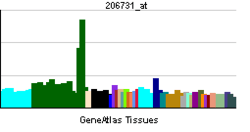CNKSR2
| CNKSR2 | |||||||||||||||||
|---|---|---|---|---|---|---|---|---|---|---|---|---|---|---|---|---|---|
 |
|||||||||||||||||
| |||||||||||||||||
| Identifiers | |||||||||||||||||
| Aliases | CNKSR2, CNK2, KSR2, MAGUIN, connector enhancer of kinase suppressor of Ras 2 | ||||||||||||||||
| External IDs | MGI: 2661175 HomoloGene: 8956 GeneCards: CNKSR2 | ||||||||||||||||
| |||||||||||||||||
| RNA expression pattern | |||||||||||||||||
 | |||||||||||||||||
| More reference expression data | |||||||||||||||||
| Orthologs | |||||||||||||||||
| Species | Human | Mouse | |||||||||||||||
| Entrez | |||||||||||||||||
| Ensembl | |||||||||||||||||
| UniProt | |||||||||||||||||
| RefSeq (mRNA) | |||||||||||||||||
| RefSeq (protein) | |||||||||||||||||
| Location (UCSC) | Chr X: 21.37 – 21.65 Mb | Chr X: 157.82 – 158.04 Mb | |||||||||||||||
| PubMed search | [1] | [2] | |||||||||||||||
| Wikidata | |||||||||||||||||
| View/Edit Human | View/Edit Mouse |
Connector enhancer of kinase suppressor of ras 2, also known as CNK homolog protein 2 (CNK2) or maguin (membrane-associated guanylate kinase-interacting protein), is an enzyme that in humans is encoded by the CNKSR2 gene.[3]
Function
CNKSR2 is a multidomain protein that functions as a scaffold protein to mediate the mitogen-activated protein kinase pathways downstream from Ras. This gene product is induced by vitamin D and inhibits apoptosis in certain cancer cells. It may also play a role in ternary complex assembly of synaptic proteins at the postsynaptic membrane and coupling of signal transduction to membrane/cytoskeletal remodeling.[3]
Mechanism of action
It is the mammalian homolog of the Drosophilia gene Cnk, which is known to bind Raf, and is implicated in ras signalling. It has been show that CNKSR2 is also a Raf binding protein, and is assumed to function in bringing together the Ras signalling complex at the post synaptic density.[4]
It is known to have two isoforms, one of which binds PSD95 and S-SCAM (synaptic scaffolding molecule) through its PDZ domain, and another which does not. Both of the isoforms are, however, known to be synaptically localized, and it is understood that this is mediated by the Pleckstrin homology domain. It's synaptic localization is not known to be affected by NMDA receptor activation. Overexpression of Maguin's C-terminal PDZ domain is known to repress synaptic localization of PSD95. In cultures, MAGUIN colocalizes with PSD95 and synaptophysin at puncta in neurites, and these puncta are first visible at 6DIV.
Proteomic work done on binding partners of Ksr2 suggests that the CNKSR2/KSR2 complex may play a role in mediating crosstalk between the MAPK, Pi3K and insulin pathways.[5] It was found to form a complex with MEK1 (Erk2, p38), MEK2, cdk4, PI3k, the phosphatases PP2A and PP^, and also various translational, ribosomal, transport and structural proteins. It remains to be established how many of these are affected by CNKSR2, and whether this remains true for Ksr2 in the nervous system.
Densin-180 is another important synaptic protein found to interact with CNKSR2. It is known to bind at its C-terminal PDZ domain. In transfected cells, no association could be found between PSD95 and Densin-180 without the presence of CNKSR2.[6] This brings it into a complex with CamKII and β-catenin, and further to the binding partners of CNKSR2 suggest that CNKSR2 may have a role in dendritic branching.
References
- ↑ "Human PubMed Reference:".
- ↑ "Mouse PubMed Reference:".
- 1 2 "Entrez Gene: CNKSR2 connector enhancer of kinase suppressor of Ras 2".
- ↑ Iida J, Nishimura W, Yao I, Hata Y (May 2002). "Synaptic localization of membrane-associated guanylate kinase-interacting protein mediated by the pleckstrin homology domain". Eur. J. Neurosci. 15 (9): 1493–8. doi:10.1046/j.1460-9568.2002.01987.x. PMID 12028359.
- ↑ Liu L, Channavajhala PL, Rao VR, Moutsatsos I, Wu L, Zhang Y, Lin LL, Qiu Y (October 2009). "Proteomic characterization of the dynamic KSR-2 interactome, a signaling scaffold complex in MAPK pathway". Biochim. Biophys. Acta. 1794 (10): 1485–95. doi:10.1016/j.bbapap.2009.06.016. PMID 19563921.
- ↑ Yao I, Hata Y, Ide N, Hirao K, Deguchi M, Nishioka H, Mizoguchi A, Takai Y (April 1999). "MAGUIN, a novel neuronal membrane-associated guanylate kinase-interacting protein". J. Biol. Chem. 274 (17): 11889–96. doi:10.1074/jbc.274.17.11889. PMID 10207009.
Further reading
- Nagase T, Ishikawa K, Suyama M, et al. (1999). "Prediction of the coding sequences of unidentified human genes. XII. The complete sequences of 100 new cDNA clones from brain which code for large proteins in vitro". DNA Res. 5 (6): 355–64. doi:10.1093/dnares/5.6.355. PMID 10048485.
- Yao I, Hata Y, Ide N, et al. (1999). "MAGUIN, a novel neuronal membrane-associated guanylate kinase-interacting protein". J. Biol. Chem. 274 (17): 11889–96. doi:10.1074/jbc.274.17.11889. PMID 10207009.
- Ohtakara K, Nishizawa M, Izawa I, et al. (2003). "Densin-180, a synaptic protein, links to PSD-95 through its direct interaction with MAGUIN-1". Genes Cells. 7 (11): 1149–60. doi:10.1046/j.1365-2443.2002.00589.x. PMID 12390249.
- Strausberg RL, Feingold EA, Grouse LH, et al. (2003). "Generation and initial analysis of more than 15,000 full-length human and mouse cDNA sequences". Proc. Natl. Acad. Sci. U.S.A. 99 (26): 16899–903. doi:10.1073/pnas.242603899. PMC 139241
 . PMID 12477932.
. PMID 12477932. - Lanigan TM, Liu A, Huang YZ, et al. (2003). "Human homologue of Drosophila CNK interacts with Ras effector proteins Raf and Rlf". FASEB J. 17 (14): 2048–60. doi:10.1096/fj.02-1096com. PMID 14597674.
- Ota T, Suzuki Y, Nishikawa T, et al. (2004). "Complete sequencing and characterization of 21,243 full-length human cDNAs". Nat. Genet. 36 (1): 40–5. doi:10.1038/ng1285. PMID 14702039.
- Gerhard DS, Wagner L, Feingold EA, et al. (2004). "The Status, Quality, and Expansion of the NIH Full-Length cDNA Project: The Mammalian Gene Collection (MGC)". Genome Res. 14 (10B): 2121–7. doi:10.1101/gr.2596504. PMC 528928
 . PMID 15489334.
. PMID 15489334. - Ross MT, Grafham DV, Coffey AJ, et al. (2005). "The DNA sequence of the human X chromosome". Nature. 434 (7031): 325–37. doi:10.1038/nature03440. PMC 2665286
 . PMID 15772651.
. PMID 15772651. - Ewing RM, Chu P, Elisma F, et al. (2007). "Large-scale mapping of human protein–protein interactions by mass spectrometry". Mol. Syst. Biol. 3 (1): 89. doi:10.1038/msb4100134. PMC 1847948
 . PMID 17353931.
. PMID 17353931.
This article incorporates text from the United States National Library of Medicine, which is in the public domain.